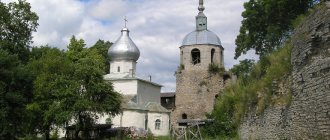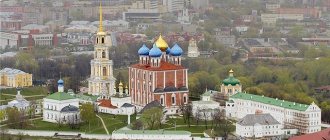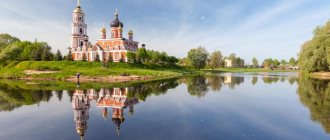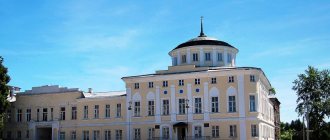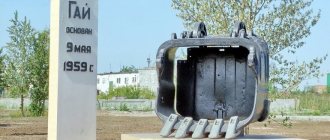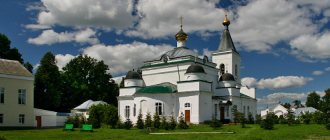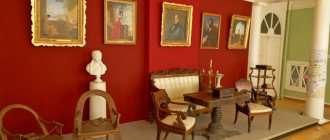The history of the emergence and development of the city of Kirov
The location of modern Kirov is the southern slopes of the Smolensk-Moscow Upland. The Bolva River flows nearby. The Pesochnya River flows into it. The city has 2 reservoirs - the Upper, formed after the construction of the dam, and the Lower, located within the city.
Archaeological finds prove the presence of human settlements along the banks of the Bolva River back in the Stone Age and settlements in the ancient and Middle Ages. And now there are mounds telling about the battles of the 13th-14th centuries.
Ivan III in his spiritual letter mentions the village of Fominichi. In various chronicles there are records of wooden churches of the 16th century, and of a monastery in Berezhki, operating in the 17th century.
The village of Pesochnya appeared in 1745. The name is associated with the nature of the soil and the river. Then the Zolotarev merchants created a metallurgical plant that produced cast iron dishes, oven castings, and nails. Four years later, ownership of the enterprise passes to the great-grandfather of Natalya Goncharova (Pushkin’s wife) - Afanasy Goncharov. He and his heirs owned it for 90 years. During this time, the following appeared in the village:
- Church of the Nativity of the Blessed Virgin Mary made of stone;
- plant management, consisting of 2 floors;
- house at the estate;
- new factory buildings - sawmill, nail factory.
In 1839, the Pesochensky factories were acquired by Ivan Maltsov. The Upper Plant continued to produce kitchen and stove castings. And the Nizhne Pesochensky Hammer Plant was repurposed for the production of earthenware dishes. Local white refractory clay was used to make it.
This is what the faience factory looked like
Sergei Ivanovich Maltsov, the owner of industrial enterprises, played a huge role in the history of Russia. His many actions surprised contemporaries and historians:
- During the years of serfdom, corporal punishment was not used against its peasants.
- Houses were built for them at the expense of the owner.
- In hard jobs, people worked 8 hours a day. This has never happened in Russia before.
- Maltsov financed the opening of educational institutions and hospitals.
His contribution to the creation and development of railways and railway engineering in Russia is enormous. On trips to Europe, he was interested in new products in this industry. He then met with Emperor Nicholas I and presented his projects to him. He proposed to involve exiles in the construction of railways. He created several railway projects. In addition, he put forward the idea of creating rail rolling plants in Russia. Then, one of his factories begins to produce steam locomotives and carriages.
The middle of the 19th century was the time of construction of stone houses on Bolshaya Pesochnya Street. Currently it has been renamed Proletarskaya. This street connected two factories and the villages created by them. But the division of the city into Upper and Lower exists even now.
A narrow-gauge railway appeared in Pesochnya in 1881. It connected the village with Bryansk and Dyatkovo. Not only freight trains moved along this road, but also passenger trains. Passengers were transported along it until 1932, when the Fayansovaya station was opened. Later the road was destroyed. A very small section has been preserved for the transportation of goods from the Kirov plant to Fayansovaya station.
Next to the iron foundry there was a station (wooden building), a room for steam locomotives and an extension for the locomotive crews to rest. With Maltsov's participation, an enamel factory was built.
Since 1936, the village of Pesochnya was given the status of a city and given the name Kirov. During the Great Patriotic War, the city's industry suffered greatly - some enterprises were evacuated to the rear, and the remaining factories suffered enormous damage. It was necessary to rebuild damaged residential buildings, restore communication lines for power, water and heat. The city is divided into 4 microdistricts:
- Upper;
- Lower;
- Earthenware;
- Zhilino.
A workers' settlement near the Fayansovaya railway station served as the basis for the creation of a microdistrict with the same name. It is separated from the city center by the Bolva River. A significant part of industrial and transport enterprises are located in the northern part of the microdistrict.
There is no industrial production in the Zhilino residential area. This is a picturesque area with one-story buildings and natural landscaping. In terms of economic benefits, the city is not in a particularly advantageous location, since there is no direct connection with Kaluga and Moscow. So, for example, from Moscow Kirov is located at a distance of 250 km in a straight line, by highway - 285 km, and by railway - 333-383 km. But through the main railway St. Petersburg - Donbass the city has connections with Bryansk, Murmansk, cities of Southern Ukraine and Crimea.
The connection between the city and the lives of famous people
The lives of many famous people are closely intertwined with Kirov:
- In 1966, Yuri Gagarin visited it.
- Maxim Goretsky, a Belarusian scientist and writer, lived there for the last 2 years of his life. He worked as a teacher of Russian language and literature at secondary school 1.
- The first president of the Chechen Republic, Dzhokhar Dudayev, had his first meeting with his future wife while serving in the Shaikovka garrison.
- Konstantin Bushuev, a well-known scientist in the rocket science industry, graduated from the Pesochensky Industrial College.
Natives of this area are Demichev (former Minister of Culture), Chistyakov (children's writer), Ovsyankin (sculptor), Eremenkov (participant in the First World War, the Civil War and the Great Patriotic War).
Housing and communal services and other infrastructure
Utility workers in Kirov have become completely insolent. Housing and communal services tariffs are rising throughout the country, but only in Vyatka they managed to double them! But, however, the townspeople rebelled and somewhere at the beginning of 2012 they wrote to Prime Minister Putin at that moment about the lawlessness that was happening. The election race was going on, and such a letter could not go unnoticed. The regional governor was reprimanded, and tariffs dropped to the average level - about a thousand rubles per person.
But the general state of public utilities, of course, is not encouraging. Soviet-era houses are dilapidated, facades are crumbling, and roofs are leaking. The residents of the top floors are unlucky - the ceilings of their apartments are covered with mold, and in some places they have completely collapsed due to constant dampness. Housing and communal services just throw up their hands, patch up attics every year, sue angry residents, but do not compensate for the consequences of leaks and are not going to spend money on a full-fledged overhaul of houses. In general, this organization does not particularly like construction work.
In Kirov (in the center!) there are many houses where there is no central gas supply - once every few months the residents of such “full-sized” houses are delivered cylinders! And how many letters and requests were written!
What's this! Some houses cannot be connected to central heating - their residents pay huge bills in winter for heating the apartment with electricity or gas. Housing and communal services remember that they need to collect monthly fees, but forget about their obligations.
Old houses are located right inside new neighborhoods
Also, utility workers don’t like to systematize anything and don’t see the point in having a proper file cabinet. How else can we explain the fact that there is constant confusion in receipts - some will be charged less, some more than they should be, and some will turn from an owner of square meters into a tenant of social housing? And every time you have to go to the organization, sort out the documents, write a complaint, etc. We remind you that this is the 21st century, but in the Kirov housing and communal services there are antediluvian computers, apartment cards are not entered into a common database, and girls sitting in the window are simply “not in the know” and it can be very difficult to get an intelligible answer from them to your question.
But it’s not just home improvement that’s suffering. If you look at the roads, it becomes scary. As in one joke - I wish the one who came up with patches on asphalt to wear darned socks for the rest of his life. Kirov has never been known for its smooth roads - it generally stands on several hills - the streets “dance”. No, if we put in a normal covering, maybe then there will be fewer accidents? But Kirov residents are not looking for easy ways. Every day, utility services fill holes in the roads - there are a lot of “holes”, but the city budget does not plan to purchase new asphalt.
The Governor's car is also forced to look for a parking space.
So, due to bad roads, even in such a small town as Kirov, traffic jams appeared. But it’s not because there are a lot of cars and everyone is in a hurry to get somewhere that the accident is to blame. Some car will get stuck in a pothole and block all traffic. So you need to plan your time in Vyatka with plenty of reserve. Moreover, there are no other options other than ground transport here. The city is too small for the metro; they didn’t even allow a tram into Kirov; they decided that trolleybuses, buses and minibuses would be enough for local residents. In principle, there are enough of them, they run often, but after 22.00 you have to take a taxi - city transport stops operating at this time.
The kindergarten issue in Kirov is acute. There are traditionally few preschool institutions. Instead of building new kindergartens, the administration is renovating the old ones again! In principle, it’s not bad, it’s better for kids to frolic in clean, modern rooms, but this doesn’t make it any more spacious. And you can get to heaven for preschoolers either according to the queue or through connections. If the child’s parents do not know each other, and they did not worry about the kindergarten in advance, the grandmother will have to look after the baby, or the mother will return late from maternity leave.
But there are many schools in Kirov. In each district (if you look not at the traditional, but at the specific classification) there are at least three such educational institutions. But, of course, they all differ from each other in their level of education and composition of teachers. As in Moscow, they practice electronic queuing for classes. Those. a parent can enroll their child in absolutely any school, regardless of their place of residence. But there they will look at how full the parallel is, and decide whether to take such a student or not.
It is clear that the strong schools are overcrowded, while the “lagging behind” schools have empty desks. But here the local lyceums stand apart. This electronic recording did not affect them in any way. If you want to study with them, you will have to take exams. Even first-graders are not allowed to pass without testing. But the enrollment rate at Kirov lyceums is colossal - all their graduates become students of good Russian universities.
Upper Lake
Locals are very proud of their Lake Superior. Although it would be more correct to call it a reservoir. It was formed after the creation of a dam on the Pesochnya River. Its area is 215 hectares.
The lake is a favorite place for locals, especially in the summer.
It is suitable for swimming. Its bottom is sandy. Artists are attracted to this place by its beautiful landscapes.
Alexander Zoryukov created more than one painting near the shores of the lake. One of them is “Bay on Lake Superior”
Unfortunately, the mansion that belonged to the Goncharov family, which stood on the shore of the lake, has not been preserved.
Monument to the lumberjack foreman
If you want an interesting photo, take it near this statue. Its uniqueness will attract the attention of your friends.
Monument to a lumberjack painted as a foreman
It turns out that the role of this sculpture is to advertise a house-building plant. It serves as a pointer to it. Initially, it looked quite simple - a figure made of gray concrete, somewhat reminiscent of a woodcutter from the book “The Wizard of Oz” or a robot. Later the monument was modified. The artists of the Rudnev brothers had an idea - to transform the standing figure into a foreman. Soon he had a name - Felix.
Driving into Kirov from Moscow, you will see this statue. It is installed on Stepan Razin Street in front of the dam.
Transport
Kirov is an important transport hub. This is especially true for railway transport. The city is connected by railways to Nizhny Novgorod, Moscow, St. Petersburg, Perm, and Vologda. City transport is represented by buses and trolleybuses. The road network is well developed. The total length of bus routes is 695 km, trolleybus routes are 92 km. Of the total number of transport units in the city, there are 545 buses, 120 trolleybuses, and only 39 minibuses.
Smolovsky cult stone
The Smolovka forest area attracts tourists with its huge stone temple. A temple is a sanctuary, a place where services were held and all kinds of rituals were performed.
According to an ancient legend, human sacrifices were performed at this stone.
It is all painted with ancient signs - runes. A significant part of them is poorly visible. There is debate about the origin of these signs:
- Early Christian myths explain their origin as “the traces of the Virgin Mary.”
- Other assumptions are that they are the first letters of the names of people who became victims of rituals.
In order to study them, you need to clean the overgrown covering of the block. There is more than one such “special stone” in the Kaluga region, but the boulder from Smolovka is the largest of them. Next to him lay another stone, smaller in size. But in the 50s he was taken to an unknown direction. This event is attributed to the fight against superstitions.
You can get to the stone by walking along the alley from Academician Frolov Street to Chkalov Street.
Ancient Rus'
Man lived along the banks of the Neruch, Uzhat, Bolva rivers and their tributaries already during the Mesolithic period - 15-20 thousand years ago.
On the territory of the region there are archaeological monuments: sites of the Stone Age (Mesolithic, Neolithic), settlements of the early Iron Age, settlements of the period of Ancient and Medieval Rus', and some objects, for example, burial grounds of the period of Ancient Rus', contain several, or even more than a dozen embankments, i.e. are complex, group monuments. In the 12th-13th centuries, the territory of present-day Kirov was part of the Bryansk Principality and was the border of Russey and the Principality of Lithuania. On the banks of Bolva and Pesochenka, mounds are still preserved - silent witnesses to the battles of the 13th-14th centuries. The origin of some settlements in the region goes back to ancient times: the village of Fominichi is mentioned in the spiritual charter of Ivan III in 1504, in the village of Berezhki in the 17th century. a monastery operated, and in the villages of Anisovo Gorodishche, Voskresensk, Slobodka already in the 16th century. wooden temples are mentioned.
The city arose in 1744-1745, when on the banks of the Pesochenka River in the Fominichsky camp of the Serpey district of the Kaluga province, enterprising merchants Ivan and Peter Zolotarev founded a small metallurgical production. The foundation of the plant, which later became known as the Verkhne-Pesochensky iron-making and hammer plant, began in the summer of 1744, and this event served as the basis for calculating the current city from there. The founding date of the plant is December 2, 1745, when the blast-furnace foundry was launched and the first cast iron products were molded. In addition to the production of cast iron utensils and furnace casting, part of the cast iron was converted into iron, and a large number of different products were made from it: from strip iron and nails to machine parts and mechanisms.
Two churches of the Nativity of the Blessed Virgin Mary
When talking about a church with this name, it should be borne in mind that there are several of them in Kirov. Therefore, there is often confusion about their location. One of them is the oldest surviving church in the city. It was erected in 1768 with funds allocated by Ivan Goncharov, the owner of an iron foundry. The brick building was built in the style of provincial classicism. Later it was subject to restructuring. Under Maltsov, a clock was installed on the upper tier of the bell tower. After the temple was closed in 1932, the bell tower and the top of the building were demolished, and the apse was replaced with a new extension. The building was visited by: House of Culture, House of Pioneers, cinema, shops. But in the end it was returned to the believers.
This is what the church looks like now
Its location: Factory Square.
Another church is located in the city cemetery. Outwardly, it looks simple - like a village hut. However, its popularity is great.
This is an ordinary plank building in the shape of a rectangle.
There is a belfry nearby. The temple has a complicated history. The date of its creation is 1907. After the destruction and closure of other churches, for a long time it remained the only place that received believers.
It was closed in 1932. But until 1948, services were held in a small wooden chapel without windows measuring 10*10 meters. The building was not heated. Then an extension was added. The area has doubled. Believers petitioned various authorities for the return of the church building, where the finance department was located. Since 1956, after restoration, divine services have resumed there.
Address: Kirova street, 48.
Crime in Vyatka style
Kirov is such a quiet province that even in the famous 90s nothing terrible happened here. No one was rolled into concrete or guarded. Local businessmen quietly divided their zones of influence, traded, shuttled, opened new stores and built residential buildings.
Vyatka is not a serious criminal area; all crimes, both then and now, happen here due to stupidity and drunkenness. The 43rd is a poor region, even officials, let alone large mafia structures, are not interested in stealing there!
Alexander Nevsky Cathedral of Kirov
This temple ranks 2nd in Kirov by date of construction (1890). But in terms of grandeur and beauty, it is on the first step. Its construction lasted for 7 years. The sponsors were wealthy residents and craftsmen of the village of Pesochensky Zavod. Industrialists Maltsov made a significant contribution. The building is 53 m long and 16 m wide. According to its layout, it can be divided into 3 parts:
- a central cube-shaped part with a towering rotunda covered by a hemisphere;
- refectory;
- bell tower of 2 tiers.
The structure is surrounded by a wide smooth frieze and a crowning stepped cornice. The windows on the rotunda (16 pieces) emit a lot of light into the building. The painting of the dome inside was done by a painter from the Perebrovshchikov faience factory. 17 frescoes were full of full-length images of Jesus Christ, apostles, and saints. They have not been preserved to this day.
Since 1891, there was a parochial school at the temple. The building erected for it (1907) survived. It houses the Sunday School.
After the building was transferred to the factory club, it underwent reconstruction, which distorted the architectural design of the cathedral. Work was carried out to plaster the walls, fill in some windows, eliminate decorative facades, and add an extension. The refectory was turned into an auditorium, and a library was placed in the central part.
By 1990, the building had fallen into disrepair. We managed to find drawings for the construction of the temple. Since then, work began on its restoration:
- carried out dismantling of partitions, interfloor ceilings and stairs; the central dome was covered with galvanization, a drum with a cross and a dome was installed;
- they covered the roof over the altar;
- replaced the doors with oak ones, the windows of the temple, refectory and rotunda;
- laid floor tiles;
- equipped with heating;
- We manufactured and installed a new iconostasis with wooden carvings by local craftsmen.
2012 is the time for the creation of a new bell tower instead of the extension added during the Soviet years. A team of workers from JSC Kirov Stroyfarfor, later renamed Kirov Ceramics, took an active part in the restoration of the cathedral.
Exterior view of the Alexander Nevsky Church
Cathedral address: Proletarskaya street, 244.
Where to go to work, or city-forming enterprises of Kirov
Some Kirov residents prefer to study and work in their hometown. In principle, you can find a good bread place here. There are several, “Mayak”, the same Biokhim, who are interested in the influx of young specialists and provide them with luxurious working conditions. This includes a good salary by Kirov standards, and all kinds of cash grants, and subsidies for the purchase of housing. Let us repeat - young people are trying to leave Vyatka, and if the “golden” head nevertheless decides to stay at the Kirov enterprise, they will groom and cherish it.
Avitek
To get paid well, you need to work on the resource. This is either communications, production, construction, government or similar things. Therefore, organizations in which it is beneficial for Kirov residents to work belong to similar areas. True, recently the central offices of strong Kirov organizations have been moving to Nizhny Novgorod - closer to the capital. For example, Rostelecom is a provider of telephone and Internet services in Kirov. A state-owned enterprise. Its employees receive a flat salary (from 20 thousand rubles + bonuses) and do not face the problems of delays and non-payments. Many would like to work there, but there is a strict selection and age limit.
And recently there have been layoffs at the company. Half of the processes were automated, and the organization of telephone services was transferred to Nizhny.
Those who are employees of organizations responsible for supplying basic communications to homes: electricity, water and gas also earn good money. These are Kirovelektrosvyaz, Vodokanal and Kirovregiongaz. In the cases of these companies, again there are no delays in monthly payments, paid vacations and sick leave are provided.
Some Vyatka construction organizations (for example, Severstroy) can also be called stable places of work. But when applying to such companies, you need to look at their track record - unfortunately, a lot of enterprises remained in debt to their employees - and the courts and bailiffs could not help the deceived people in any way - confiscations and inspections showed that the company was bankrupt and it never had anything did not have!
For those who do not have a higher education or who are not attracted to work in a technical company, the doors of large stores and shopping centers in the city of Kirov are open. People will always eat, so joining the local grocery chain Globus is a good step. The official salary there is small, but an ordinary salesperson receives about 15 thousand in an envelope.
Globus shopping center in Kirov
Payments are stable, since the company has large income. Lately, the Moscow Pyaterochka has been trying to interrupt it. Capital entrepreneurs bought several areas in the city center. They say they pay the same. Working conditions are not very different from Globus, but, probably, Kirov’s Pyaterochka is in the red for now. For a long time she resisted and did not want to sell the products of local dairy, bread and meat production, so they did not particularly go to these stores. Moreover, the quality of services did not differ from Globus, but the packages (at the ready of the local grocery chain) at the checkout of Muscovites were paid.
Now “Pyaterochka” has worked on its mistakes and on its shelves there are products of the local bagel and confectionery plant - “BKK”, meat production “KMK” and fermented milk products of the “Vyatushka” brand.
By the way, it is also profitable to work in the above companies. Every year, Kirov products take some places in all-Russian competitions and are sold not only in the 43rd region, but in neighboring regions. This means that the employees of these enterprises are loaded to capacity, but also receive a corresponding, far from small salary.
In general, there are many companies in Kirov. And, if young people went into production, and not into managers, there would be no shortage of labor. Everyone would receive a decent income, and not measly handouts for sitting in the office. Kirov is not Moscow. Resales and telephone marketing will not work in a small town. In a quiet province, to achieve success, you need to work on the resource - this is the easiest way to earn a living.
Kirov Museum of History and Local Lore
Every city has a museum dedicated to the history of the region. Kirov is no exception.
The museum was created in the building of a former cinema
Visitors are presented with exposition and exhibition halls. In the first room they get acquainted with ancient objects and historical documents of the Pesochensky region. In another room, various exhibitions are constantly organized.
The exhibition hall began its work in 1989. The first exhibition was dedicated to the works of Kosenkov, a Kirov landscape painter. Then the theme in this hall changed. Exhibitions were presented:
- historical and documentary with exhibits from the museum and private collections; works of children's creativity;
- wax figures;
- artists of the region;
- photo exhibitions.
The exhibition hall received its visitors in 1993. The museum's funds are constantly replenished. They number up to 19,000 storage units. Among them there are archaeological finds, numismatic and ethnographic objects, personal belongings, diaries of famous geologists, and original porcelain vases. Participating in the work of the museum are:
- archaeological expedition;
- clubs of collectors and embroiderers;
- employees of branches of scientific communities - geographical, literary, genealogical;
- public activists who help personally in the work of the museum or financially.
Those who want to learn more interesting facts can go on a tour of historical places and purchase books and paintings as souvenirs.
The museum is located at: Lenina Street, 1.
Geographical features
Many people are interested in the question: where is the city of Kirov? This regional center is located in the valley of the Vyatka River, in the middle part of its course, on the Russian Plain. Part of the Volga Federal District. Located in the taiga forest zone. Kirov is located in the Moscow time zone.
The climate is determined by where the city of Kirov is located. It's continental and cool. Characterized by frequent incursions of cold air masses from the Arctic Ocean located in relative proximity. Therefore, severe frosts are common in winter, and sudden cold snaps in summer. The city itself is noticeably warmer than the surrounding area. Annual precipitation is 677 mm. Most of them fall in the summer.
Within the city limits there are agricultural lands and specially protected natural areas.
